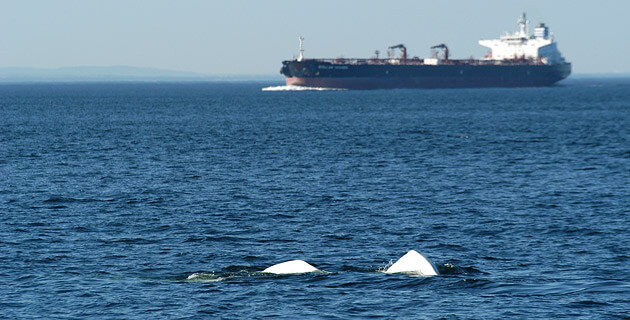In a press release, GNL Québec has undertaken to set up a $5M fund to support projects reducing the underwater noise footprint of ships plying the Saguenay. The fund would materialize if GNL Québec receives all the necessary authorizations to launch its proposed natural gas pipeline and liquefaction plant.
The fund is part of a broader “Charter of environmental commitments for the protection of marine mammals”. This charter was developed by the company, in collaboration with an environmental consulting firm, as part of the environmental assessments submitted to the Governments of Canada and Quebec. It aims to enhance the mitigation measures already being proposed in the context of the environmental assessments. The assessment contains a section addressing underwater noise, one of the threats faced by the endangered St. Lawrence beluga population. Belugas rely on sound to orient themselves, hunt and communicate.
“Generally, any noise-reduction measure in the Saguenay is good news. However, we really need to talk about a noise reduction compared to current levels and not simply mitigating the impact of an increase in noise,” says Robert Michaud, beluga expert and scientific director of the Group for Research and Education on Marine Mammals (GREMM). “Additionally, if the project receives authorizations from the two levels of government to begin, GNL Québec could be obligated to implement mitigation measures much more stringent than those being proposed today. And in this case, we will not be talking about a fund, but rather mandatory investments for compliance,” he adds.
In an interview with Le Quotidien, senior director of public affairs and community relations Stéphanie Fortin states, “What’s remarkable about the addition of our boats is their size. In terms of numbers, we’re talking about three or four per week, which will nevertheless increase maritime traffic. From a technical point of view, the impact is not considered to be significant.” Upon reading this statement, Clément Chion raises his eyebrows. This associate professor in the Department of Natural Sciences and researcher at ISFORT at the Université du Québec en Outaouais studies the interactions between watercraft and belugas in the St. Lawrence. He is currently working with GREMM and federal ministries on a simulation model to analyze noise propagation and its impact on St. Lawrence belugas at the individual and population levels. Research is in progress. “The Saguenay is a sensitive area for belugas. It is very narrow, and, on the contrary, it is feared that each encounter between a ship and belugas in this watercourse will have a high impact,” he points out.
The announcement comes a few days after the publication of an open letter signed by researchers and university professors who oppose funding a research chair, as announced in November by GNL Quebec. At that time, the company was proposing $350,000 of funding for an inter-university chair on carbon sequestration. “Private research funding is raising debate in academic circles […]. . Concerns expressed include the risks of conflict of interest and self-censorship,” argue the academics. Another letter signed by some one hundred professors, lecturers and support staff from the Université du Québec à Chicoutimi was also released last week to speak out against the project.
Robert Michaud notes that the multiple announcements being made to the community are part of a charm campaign orchestrated by GNL Quebec. In an interview on Style Libre (in French) on the Ici Saguenay–Lac-Saint-Jean program, he explained: “GNL has a marketing team that is currently extremely aggressive and I think they need to take a step back as, let’s remember, they’re in the midst of completing their environmental and social assessments, which are both serious and important. And, completion of the project should not depend on the quality and size of the gifts they can give out left and right.”





